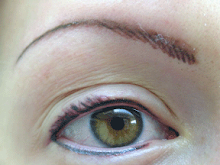Some Before and Afters:





*NOTE: Colors soften after procedures heal.
Sunday
Saturday
Before and After - Permanent Makeup
This client came to Image Perfect Studios seeking makeup that would ease her daily routine. She felt washed out and blah before her procedure... 
Wow! Look at the difference! (This photo was taken just after lip touch-up procedure. Lip color will heal softer than shown. Eye procedures are healed.)
Posted by The Artist Behind Image Perfect: at 9:41 AM 0 comments
Sunday
Coupon!
Posted by The Artist Behind Image Perfect: at 2:33 PM 0 comments
Thursday
Frequently Asked Questions:
What exactly are permanent cosmetics?
Permanent cosmetics is cosmetic tattooing. The specialized techniques for permanent cosmetics are also referred to as micropigmentation or dermagraphics. The cosmetic implantation technique deposits colored pigment into the upper reticular layer of the dermis to create the desired illusion.
How are permanent cosmetic procedures performed?
Permanent cosmetics procedures are performed using various methods, including the traditional tattoo machine (coil machine), the pen (rotary machine), and the non-machine (hand tool or manual method.) The procedure process includes an initial consultation, application of procedure, and at least one post procedure evaluation appointment for determining the need for adjustments to the shape and/or the density of the color.
Who can benefit from permanent cosmetic makeup procedures?
Men and women of all ages and life styles who desire a soft natural enhancement to their appearance, or procedures relating to improving the appearance of skin trauma, such as scar tissue. It is especially beneficial to people who cannot wear traditional cosmetics due to allergies and/or skin sensitivities, active people who want to look their best at all times, during sports activities, and all those who don't want the worry of refreshing their cosmetics. People that have impaired vision, skin disorders resulting in hair loss, or are suffering from dexterity challenges making it difficult to apply makeup, find permanent cosmetic procedures a service that helps normalize their lives.
What types of permanent cosmetic procedures are available?
Permanent cosmetic procedures can be very subtle or dramatic depending on what your preferences. Procedure options include:
Eyebrows Lip Color Scar Camouflage*
Lash Enhancement Beauty Marks Areola pigmentation*
Eyeliner, Top and Bottom Hair Imitation Blush and Eye Shadow*
*Advanced procedures requiring techniques acquired by experience technicians completing continuing educational advanced training courses.
Are permanent cosmetics really permanent?
Permanent cosmetics procedures are considered permanent because the color is implanted into the upper reticular part of the dermal layer of the skin. As a result, the iron oxides, or pigmenting components remain in the body regardless of the external visual appearance of the procedure. However, as with any tattoo, fading can and often does occur due to many factors. The predominant reason for the fading of the color of a permanent cosmetic procedure is decomposition of pigments due to exposure to the sun, however, your health, consumption of medications, and use of facial products containing exfoliation properties all contribute to the need for maintenance. At some time in the future, the color in your procedure will in all likelihood require refreshing.
How much does permanent cosmetic makeup cost?
The average cost per procedure varies but usually averages between $400-$800. Advanced work may be charged at $150 to $250 per hour. Many of these procedures are commonly referred to as para-medical procedures. Work performed from physician's offices or specialized clinics may be charged at higher rates. The cost of the procedure however should not be the most important issue when consulting a potential technician. More important is the client’s confidence in their technician’s training and skills and compliance with health and safety requirements.
Which technician should I choose?
Choose a technician carefully by considering training, experience, portfolio, and recommendations. Make sure your technician has years of experience or you will be the guinea pig! Cost should not be the first question when choosing a technician although I am always surprised when this question is asked first! This is YOUR FACE! Do not treat it lightly... this is permanent beautiful or horrific!
How long does each procedure take?
The initial procedure will generally take approximately 1 to 2 ½ hours whch includes paperwork. Touch-up procedures usually require less time.
Are the procedures painful?
The answer to this varies, based on each individual's tolerance to discomfort, and the skills of the technician performing the service. The permanent cosmetic Industry now has the benefits of several methods available to assist with discomfort management. For instance, there are various non-prescription and prescription level topical anesthetic preparations. Also available, only when administered by a doctor or a dentist, are anesthetic local injections. Your technician will discuss these methods with you to determine which one(s) are offered and which method best applies to the procedure being conducted.
Is it safe?
If proper sterilization and sanitary guidelines are met (Contact the governing agency in your state for specific information), and your technician is well trained for the procedure being performed, permanent cosmetic procedures should be completely safe. There have been so few reported reactions to pigments that many physicians suggest that a patch test is not be necessary, especially since most allergic reactions do not occur immediately. The possibility that you would have any serious medical problems as a result of a permanent cosmetic procedure is almost non-existent considering enforced health standards. Client compliance with post- procedural instructions is also an important element in reducing any associated risks.
Can I still have an MRI (Magnetic Resonance Imaging)?
Numerous studies have shown that even for people who have large body tattoos there is little to no potential for irritation resulting from an MRI. In the rare instance where discomfort resulted, it was localized and very temporary.
What if I don't like it?
Although the procedure is considered permanent, there is flexibility in changing color and/or shape to some extent. Client participation in color selection and final design and placement approval helps assure your ultimate satisfaction with the service. I have never personally experienced a client who said I wish I had never done this although there are a few difficult personalities I have dealt with over the years. A rarity thank goodness.
Can I resume normal activities after the procedure?
This is unique to each client. Generally, there is some swelling of the treated area. While eyebrows may show little after effect, eyeliner and lip procedures may produce more swelling and it may last anywhere from two to seventy two hours. During the procedure there may be some bleeding and although rare, some bruising. There is usually some tenderness for a few days. The color is much darker than you may expect for the first six to ten days. It is recommend that you do not plan any special events for several days after your procedure.
What's a touch-up and when do I need one?
The tattooed color or design may require an adjustment after the initial procedure. These procedures are processes and at least one follow-up to the initial procedure should be scheduled to determine if additional work is necessary. A standard measurement of time between the initial procedure and a follow up visit is one week for every 10 years of age of the client. Usually follow up visits are scheduled from 4-6 weeks after the initial procedure.
As previously discussed, after your initial and follow up visit is complete, depending on many factors unique to you, the timing for the need for a future color refresher will depend on exposure to the sun and health factors.
Posted by The Artist Behind Image Perfect: at 12:09 PM 0 comments








